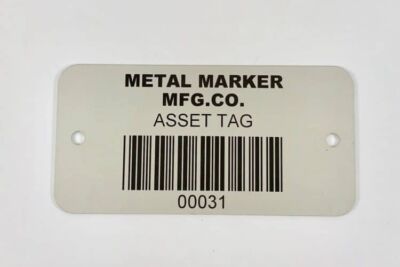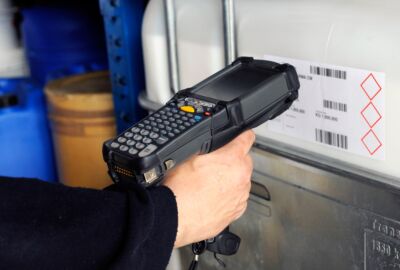 Asset tagging is a market-proven method for tracking assets that’s been around for decades. It may sound simple, but a lot of information is contained in one asset label, also called an asset tag, including the asset’s location, operational status and other collected data.
Asset tagging is a market-proven method for tracking assets that’s been around for decades. It may sound simple, but a lot of information is contained in one asset label, also called an asset tag, including the asset’s location, operational status and other collected data.
Asset tags make it easy to find physical assets in your facility because you can use an RFID scanner or barcode scanner on coded inventory tags attached to an item and pull up its location immediately.
This saves time and money by ensuring employees don’t waste work hours looking for missing items and helps prevent inventory loss due to misplaced or stolen equipment. Asset tagging also comes in handy for accounting and tax purposes as you can ensure you have accurate asset data for reporting.
From office equipment to medical equipment and power tools, asset tagging tools can be used for all kinds of physical inventory. Here’s why asset tagging is important to protect your business assets and your physical capital with a strong asset tagging system and durable asset labels.
Helps With Asset Tracking
Whether you have a single or multi-site business, asset tagging is a valuable tool for inventory management to keep track of where equipment is and what condition it’s in at all times. Without asset tags and an asset management system, your business is vulnerable to lost equipment, profit loss and other issues that result from failure to maintain accurate records.
Asset tagging with RFID tags provides visibility regarding the location, serial number and condition of each specific asset so you can track your assets consistently and accurately. RFID tags track data and make it easy to view an asset’s history with barcode scanners to read the asset tags. Thanks to the RFID tag’s long-range scanning capabilities, movable assets can have their labels scanned and recorded from several yards away. This is especially crucial for movable assets that are transported to a construction site or other job site.
Enables Maintenance History Tracking

Asset tagging is an important part of maintaining facilities and equipment. Asset labels allow maintenance staff to keep track of the maintenance history for each asset, which helps determine when it needs to be serviced. This enables you to perform preventive maintenance on each piece of equipment as needed, helping extend its longevity while saving on emergency repairs or replacements down the line. Using accurate asset tags also makes it easier to develop a maintenance schedule for individual assets.
Having a record of maintenance history for each asset through facility and equipment tagging helps with meeting compliance requirements set forth by industry standards such as ISO 9001:2015 (Quality Management Systems) and ISO 45001 (Occupational Health and Safety). It also ensures compliance with other regulations, such as those specific to energy efficiency programs or building codes, by helping companies track usage data, which can then be used for billing.
Enables Better Equipment Inventory
Asset metal tags and metal labels are an important part of the equipment inventory process. They help validate that equipment is accounted for and used in accordance with safety regulations and manufacturer specifications. Asset tagging also helps ensure equipment is used according to company policies and procedures. With asset tracking labels, you can quickly identify a particular asset and ensure it’s recorded. Proper inventory management is crucial for auditing and accounting purposes. You’ll have a better sense of where your inventory stands and be able to identify further opportunities to generate revenue with accurate asset information.
Ensures Safety Compliance With Industry Standards
Using asset tags and an asset tracking system can help ensure your business is operating safely and in line with industry standards. A company that produces components for the automotive industry, for example, must comply with industry standards and regulations in order to sell its products. Asset tagging is one way to establish close compliance with these standards.
Asset tagging can also serve as an extra safety precaution for employees and equipment, both on-site and at remote locations. In addition to the obvious benefits of keeping track of who’s wearing what protective gear (and making sure they’re wearing it), asset tagging can provide a record of when inspections were last performed or what was inspected during that time — making it easier for your business to monitor how often certain parts need replacing or know when repairs are needed due to operational wear and tear.
Prevents Job Site Theft
 Job site theft is always a concern in the construction industry and across any sector that relies heavily on high-value assets. Asset tags can help prevent theft by improving asset visibility and making it easier to locate assets if they go missing.
Job site theft is always a concern in the construction industry and across any sector that relies heavily on high-value assets. Asset tags can help prevent theft by improving asset visibility and making it easier to locate assets if they go missing.
An asset tag can serve as a theft deterrent as well. If employees know assets are being tracked, they’re less likely to risk the fallout from attempting to steal from the workplace.
Get Started With the Asset Tagging Process
The benefits of asset tags and labels are almost too numerous to list. Are you ready to find out how asset tagging operations and asset tracking software can help optimize your business operations? Whether your owned assets include medical assets, fixed assets or any other type of physical assets, tagging assets with durable RFID tags offers a welcome alternative to manual data entry and makes it easier to implement regular maintenance schedules.
Metal Marker Manufacturing is here to help you get started with the asset tagging process and ready to help you develop a solution that’s right for your needs. Call 1-800-428-0095 or contact us online today.